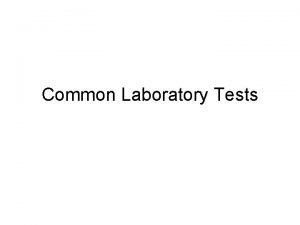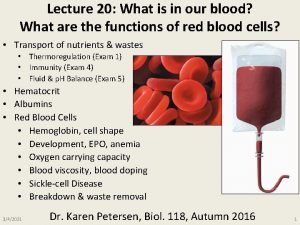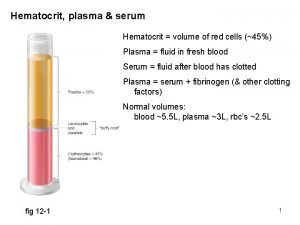Microhematocrit Determination Microhematocrit Hematocrit Test that provides a







- Slides: 7

Microhematocrit Determination

Microhematocrit • Hematocrit — Test that provides a health care worker with an estimate of the patient’s red cell volume. — Remember that the RBCs determine a person’s oxygen capacity. — A hematocrit measurement is used to screen for anemia, blood donation, evaluating therapies and treatment, as well as assessing blood loss. • A hematocrit can be measured manually (microhematocrit) or by using a hematology analyzer. • A hematocrit is included as part of a CBC (complete blood count).

Microhematocrit • Microhematocrit — Test involves only a small amount of blood. — The test uses the separation of cellular components by centrifugation. —Whole blood is centrifuged in a capillary tube. — Red cells settle at the bottom with the buffy coat (WBCs and PLTs) resting just above the RBCs. — The remaining liquid is plasma. — The microhematocrit is determined by comparing the volume of RBCs to the total volume of the whole blood sample. — This number is expressed in a percentage. — A microhematocrit is also known as a crit or Hct.

Microhematocrit Equipment/Reference Values • Microhematocrit Equipment — Microhematocrit centrifuge — Microhematocrit tubes —Capillary stick supplies • Hematocrit Reference Values — Like hemoglobin, hematocrit values differ based on age and gender. — Adult males range from 42 -52 % — Adult females range from 36 -48 % — Newborns range from 51 -61 %

Microhematocrit Reference Values • Hematocrit Values — Hematocrits below normal can point to…… ü Anemia ü Current bleeding — Hematocrits above normal can point to…. . ü Dehydration üPolycythemia • In a healthy person the hematocrit should be equal to the hemoglobin multiplied by 3. • Example: If you have a hemoglobin of 15 g/d. L your hematocrit should be around 45%.

Performing a Microhematocrit • Performing a Microhematocrit — The sample of blood can be collected from a capillary puncture or from an EDTA tube collected from a venipuncture. — Capillary blood should be collected into a heparinized capillary tube. — All blood needs to be mixed thoroughly. — Clay can be used to seal the capillary tube or self sealing tubes can be used instead. — Sealed tubes need to be centrifuged in a microhematocrit centrifuge.

Reading a Microhematocrit • Reading a Microhematocrit — You can determine the percent of RBCs in the sample by using a microhematocrit reader.












